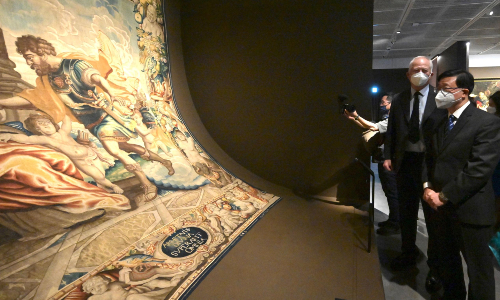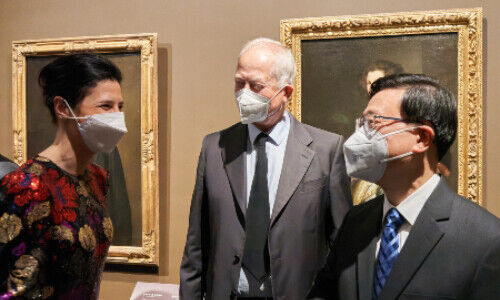More than 100 works of fine art including pieces by Peter Paul Rubens and Anthonis van Dyck are trading Vienna for Hong Kong. The collection reveals an age-old fascination with Chinese art and culture by European nobles.
The scene is a different one from the splendor of Vienna’s City Palace, but no less grand: Hong Kong’s newly opened Palace Museum (HKPM) is one of the largest and most ambitious cultural projects in the world. It represents a bold attempt to redefine Hong Kong as not just a financial center, but a home to fine art as well.
The Princely Family of Liechtenstein is sending 130 works of fine art from their Princely Collections, which span six centuries, to Hong Kong. The visiting exhibition highlights the long-standing ties between the finest works of Chinese and European art. It was opened this month by John KC Lee, Chief Executive of Hong Kong, H.S.H. Prince Hans-Adam II, Reigning Prince of the House of Liechtenstein, and H.S.H. Princess Adelheid Coudenhove-Kalergi, Board Member of LGT Private Banking.
Age-old Fascination with Chinese art
The seven-story HKPM marries traditional Chinese aesthetics with modern architectural techniques. While the HKPM currently caps attendance at 5,000, Director Louis Ng envisions as many as 2.2 million annual visitors eventually. The Princely House of Liechtenstein represents the first visiting «exhibition of dialogue» in one of nine HKMP galleries.
The exhibition, sponsored by LGT, a leading international private bank owned by the Princely Family, reveals an age-old fascination with Chinese art and culture by European nobles. For example, polychrome porcelain elements predominantly from 17th and 18th century China adorned the Princely Family’s Vienna palace. The summer residence – Lednice Castle – housed watercolors depicting a Chinese-style garden.
«White Gold» Porcelain
One of the earliest documented contacts between Europe and China dates back to 1266, when Marco Polo first visited China, according to Johann Kraeftner, Director of Princely Collections. The links were sometimes intense and sometimes casual – and Chinese porcelain built a bridge.
«Undoubtedly, the magic of the ‹white gold› porcelain sea freight shipments at European royal courts, as well as at the Ottoman Empire, was an anchor,» Kraeftner said. «Soon export porcelain popped up, speculating European shapes, decorated in European influences, or even painted with the crest of the families they were intended for,» he added.

Besides works of porcelain, the «crown jewels» of the Hong Kong exhibit are masterpieces (pictured above) by Peter Paul Rubens and Anthonis Van Dyck. The two influential Flemish Baroque artists were an early, intense focus of the collection: Prince Johann Adam Andreas instructed his art dealer to keep on the lookout for pieces by Rubens. By 1700, he had built up one of the largest private collections of Rubens and of Van Dyck.
This collection of Rubens – ranging from his early work in Antwerp, his time studying with Italian masters, and his «diplomatic» trips to France, Madrid, and London – is a focal point of the Princely Collections.
Dialogue and Cultural Exchange
Opened just months ago, the HKPM is intended as a platform for East to meet West – and the Princely Collection is intended to foster dialogue between two civilizations and strengthen the exchange of art and culture internationally. Both Liechtenstein’s Princes, as well as Chinese emperors, collected, and both made their art accessible to the public.
Each reigning Prince contributed to expanding and enriching the collection through personal taste and style. Though many of its works had to be sold in the 20th century, some were later repurchased. An early 18th-century wool and silk tapestry from Jean II Barraband Manufactory – The Audience with the Emperor of China (from the «Grand Mogul» cycle) – is a prominent example: Hans-Adam II, current reigning Prince of Liechtenstein, reacquired four of the tapestries on the fine art market in 2007.
No Stranger to Asia
Founded by Prince Karl I in the early 16th century, the collections are today among the most important private art collections in the world. They may have never lent to a Hong Kong museum previously, but they are no stranger to Asia: their last major visiting exhibition was in 2019, and in 2020 in Tokyo, when a selection focused on the tradition of European fine painting and porcelain made its way through Japan.
- The Princely Family remains an active acquirer of masterpieces to this day. The exhibition is open to visitors until February 20, 2023. Its sponsor, LGT Private Banking, has been present in Hong Kong since 1986.











